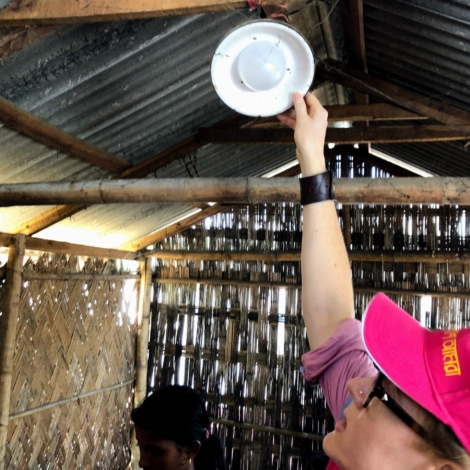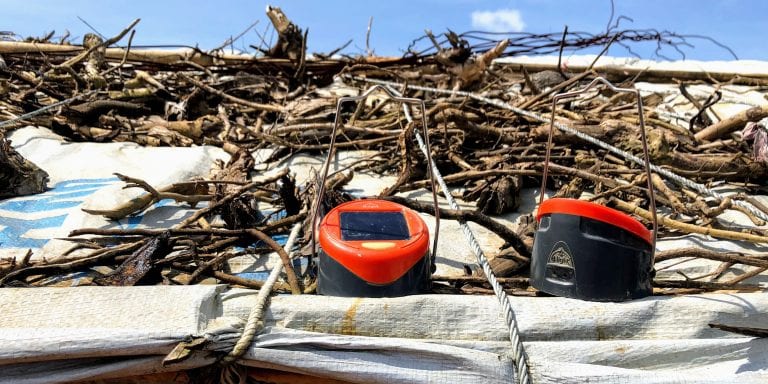Kenya is a critical hub for refugees who migrate mainly from the Horn of Africa and South Sudan. Kakuma, with its two areas of operation, Kakuma Refugee Camp and Kalobeyei Integrated Settlement, is one of the biggest camps with a population of over 185,000 refugees and asylum seekers (UNHCR, 2018). Survey results and previous research conducted by the Moving Energy Initiative[1] (MEI) have shown that households in the camps spend approximately (USD) $50 per year on inefficient lighting and power, or slightly less than half the average income in Kakuma of (Ksh) 7770, or $123, according to a 2016 report by the World Bank and UNHCR. At least 12 percent of the population pays $5 per month for diesel generators.
Running small businesses, such as shops and restaurants, is a common means of generating income in the camps. Given that grid connections will not be available in the foreseeable future (if ever), and that electricity is needed both for household and business uses, residents have sought alternatives. BBOXX, an energy company operating across Sub-Saharan Africa, started providing energy services through standalone Solar Home Systems (SHSs) under a partnership with MEI in early 2018. The company continues to serve Kakuma today, demonstrating how off-grid solar solutions can be a viable option in the context of human displacement. BBOXX’s work in Kakuma exemplifies a solution that could be implemented in other camps to serve the world’s 22 million refugees, as well as the larger group of 65 million people who have been forcibly displaced worldwide (UNHCR, 2018).
The case for distributed energy in refugee camps
There are several reasons why distributed energy is well-suited to serve refugee communities in Kakuma and beyond.
Temporary status creates a services limbo
Even though many of the refugee camps are in principal temporary, the reality is that majority of them turn into semi-permanent or permanent settlements. However, their official temporary status means that infrastructure networks do not reach them which leaves the residents in a services limbo and means they have to resort to options such as kerosene lanterns or battery-powered torches for light, and frequently diesel generators to power small businesses. These fuels are not only expensive but also polluting, in addition to posing risk of fires which can be particularly dangerous given the high density of houses in the camp. SHSs can be installed in any location and with a standard set of appliances (light bulbs, phone chargers, radios), prices will often be comparable to what households are already spending on energy, or slightly higher (in absolute terms) but also offering the ability to charge mobile phones (which comes at a cost at charging stations) and access to information.
Ownership of Solar Home Systems is transferable, maybe even portable
Despite having aspirations for one day returning to their home countries, many refugees never get that chance. Yet, on occasions when it does happen, there is a question of taking or leaving an asset behind. Although currently relocation of solar systems is not always an option, providers such as BBOXX have started looking into how customers who move countries can either transfer ownership to someone else (e.g. another household in the camp) or return the product. As solar companies spread their presence to multiple markets, there is a possibility that, in the future, people who are forced to relocate may be able to bring a system along with them.
Advances in mobile money allow people with or without phones to pay
With high mobile phone and mobile money (MM) adoption rates in places like Kakuma, Pay as You Go solar also addresses the issue of affordability. Customers can make incremental payments rather than lump sums. However, some refugees can also face challenges with setting up mobile money accounts. They often resort to using other people’s accounts, such as those of Mobile Money Agents or members of the host community[2]. This can be problematic for making payments (made exclusively though MM). However, with technological and system advances, customers have increasingly been given more flexibility to pay from any MM account, thus opening access opportunities to everyone, regardless of their status and ability to register for certain services.
Remotely monitored systems offer rare insights into underserved customers
Additionally, off-grid solar has proven invaluable in gaining insights into the underserved consumers, both in rural and humanitarian contexts where the majority of the population remains unbanked. Big data collected through SHSs proves that even in challenging settings there is a viable and bankable customer base. As most SHSs are remotely monitored, meaning that data on power consumption and payments is constantly recorded, we can learn more about energy use behavior while at the same time giving refugees (and other financially excluded) an opportunity to build their credit profiles thus expanding the range of financial inclusion avenues. Data can also be used to inform the governments, investors and the international community to encourage more meaningful involvement and more targeted investment in refugees and their economies. By doing so, it can also help the global data agenda by capturing valuable development data in places where such data is particularly scarce (IBRD & WB, 2018). The data generated from remote monitoring fill gaps in the knowledge gleaned from analog methods of survey collection that are necessary in communities that lack technological infrastructure.
Technology is no longer a privilege, it is a right
And finally, as recently highlighted by Emi Mahmoud, a UNHCR Goodwill Ambassador and an award-winning poet, “access to technology is no longer a privilege—it is a right.” To add to that, access to safe, accessible and affordable energy technologies should be, too.
References
International Bank for Reconstruction and Development (IBRD) & The World Bank (WB) (2018). Data
for Development. An Evaluation of World Bank Support for Data and Statistical Capacity. Washington,
DC: World Bank.
United Nations High Commission for Refugees (UNHCR) (2018). Global Trends. Forced Displacement in 2018. Available online: https://www.unhcr.org/5d08d7ee7.pdf
[1] Moving Energy Initiative is an initiative led by Chatham House, UNHCR, Practical Action, UK Aid, Energy4Impact and the Norwegian Refugee Council.
[2] Host community means the town where a camp is located. In the case of Kakuma, host community means the residents of Kakuma town.
About the Author
Iwona Bisaga is a Contributing Editor at Engineering for Change and a global development professional who designs and implements water, sanitation, hygiene and energy-access projects in Sub-Saharan Africa, South America and parts of Asia. Iwona’s expertise is in energy-access research, particularly through decentralized, stand-alone solar home systems in Rwanda and East Africa.

